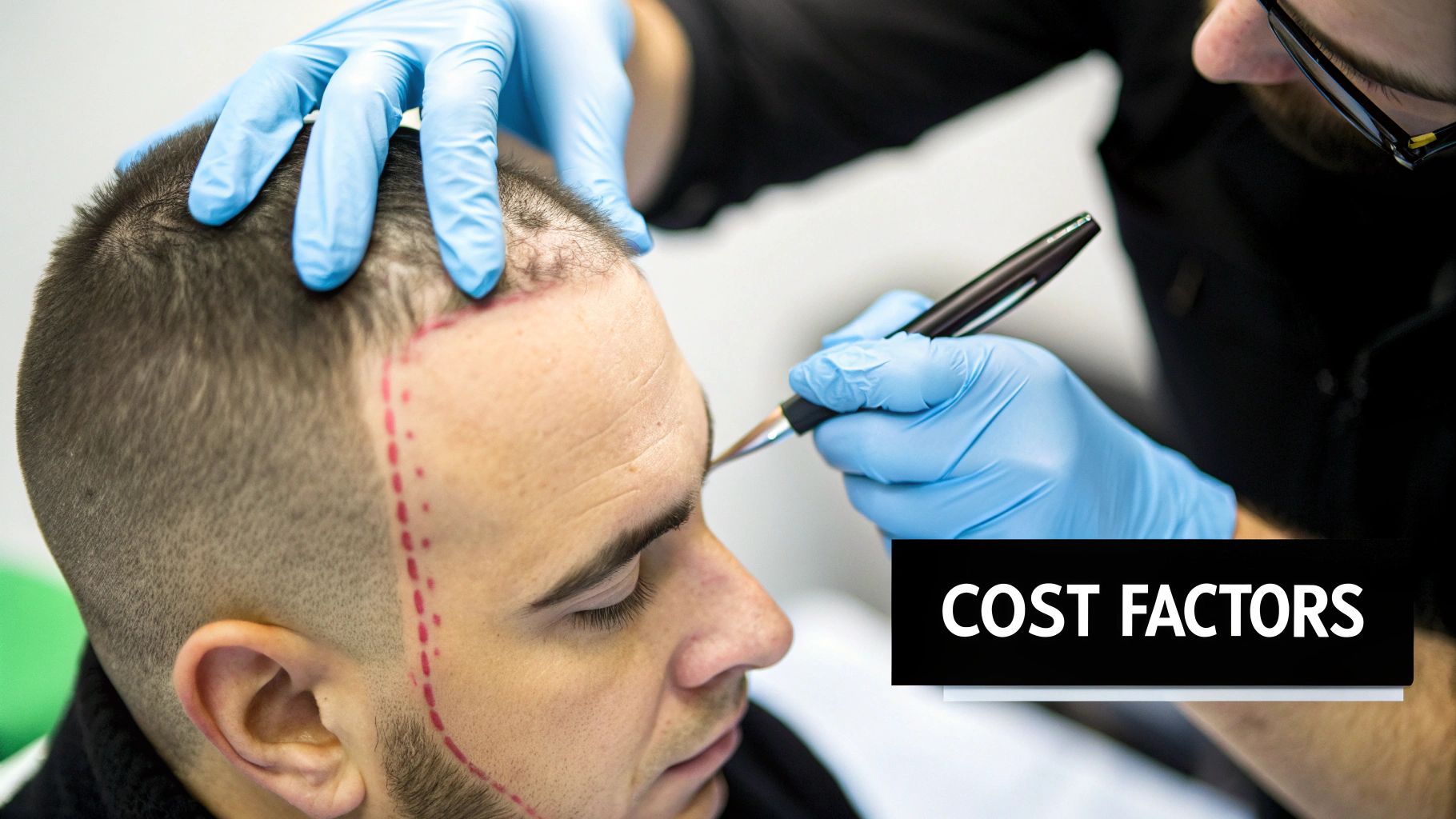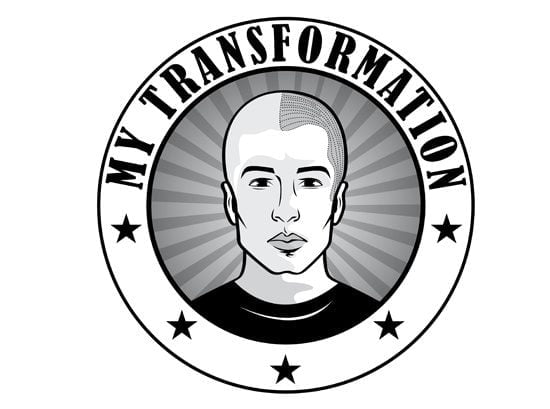
Australia's Hair Transplant Cost Uncovered
Share
Alright, let's talk numbers. When it comes to hair transplants, one of the first questions on everyone's mind is, "What's this actually going to cost me?" In Australia, you can expect the price to land somewhere between $4,000 and $15,000, though some more comprehensive procedures can certainly go higher.
It's helpful to think of it like building or renovating. The final bill depends on the scale of the job, the quality of the materials (in this case, the technique), and the experience of the professional you entrust with the work.
Your Guide to Hair Transplant Costs in Australia

Getting a handle on what you might pay is a crucial first step. The price you're quoted isn't just pulled out of thin air; it’s a carefully calculated figure based on the specific technique used, the surgeon's expertise, and, most importantly, the number of hair grafts needed to get you the result you're after.
A minor touch-up to your hairline is a very different job to restoring hair across a large area of the scalp, and the price will naturally reflect that. Let's break down what really drives the cost.
A Quick Look at the Numbers
The two main players in the hair transplant world are Follicular Unit Extraction (FUE) and Follicular Unit Transplantation (FUT). They're different procedures, so they come with different price tags.
Here in Australia, FUE is generally the more expensive option, typically ranging from $6,000 to $15,000. It's a meticulous, graft-by-graft process known for leaving minimal scarring. On the other hand, FUT, which involves removing a strip of tissue and can yield more grafts in a single session, usually costs between $4,000 and $12,000.
The basic principle is this: the more labour-intensive and precise the procedure, the higher the investment. Your quote is a direct reflection of the time and skill dedicated specifically to your case.
Estimated Hair Transplant Costs at a Glance
To give you a clearer idea of how this translates into real-world figures, here's a simple table outlining what you might expect to pay based on the procedure and the number of grafts you need. Think of it as a starting point for your budget.
| Number of Grafts | Estimated FUE Cost (AUD) | Estimated FUT Cost (AUD) |
|---|---|---|
| 1,000 - 1,500 | $5,000 - $8,000 | $4,000 - $6,000 |
| 1,500 - 2,500 | $8,000 - $12,000 | $6,000 - $9,000 |
| 2,500+ | $12,000+ | $9,000+ |
These numbers are a solid guide, but your final quote will always depend on your individual consultation.
It's also worth remembering that a hair transplant is a permanent surgical procedure. If you're looking for a non-invasive cosmetic alternative, it's a good idea to explore all your options. For instance, you might be interested in our guide on what Scalp Micropigmentation is all about, which creates the look of hair density without surgery.
What Really Drives Your Hair Transplant Quote

This infographic really puts the global differences in hair transplant costs into perspective. It's clear that where you have your procedure done is one of the biggest single factors that will shape your final quote.
If you've started looking into hair transplants, you've probably noticed that pricing is all over the map. The hair transplant cost isn't a simple, fixed number. In fact, two people with what looks like similar hair loss can get quotes that are thousands of dollars apart.
That's because your final price is a highly personalised calculation. It's built on several key factors that determine the time, skill, and resources your specific procedure will demand. Think of it less like buying something off the shelf and more like commissioning a bespoke suit. The final cost reflects the tailor's expertise, the quality of the fabric, and the sheer amount of detailed work involved.
Let's break down exactly what goes into building that quote.
The Technique The Clinic Uses
The surgical technique chosen is arguably the biggest driver of the final price. Whether your clinic recommends Follicular Unit Extraction (FUE) or Follicular Unit Transplantation (FUT) will make a significant difference to the bottom line, simply because of the labour and precision involved.
-
FUE (Follicular Unit Extraction): This is the method where individual hair follicles, or grafts, are meticulously extracted one by one from the back and sides of your head. It's incredibly detailed, time-consuming work that requires immense concentration from the surgeon. The major upside is that it leaves behind only tiny, dot-like scars that are virtually undetectable. Because it’s so labour-intensive, FUE is almost always the more expensive option.
-
FUT (Follicular Unit Transplantation): Often called the 'strip' method, this technique involves surgically removing a small strip of scalp tissue from the donor area. Technicians then carefully dissect that strip under microscopes to separate the individual grafts. While it allows a surgeon to harvest a large number of grafts more quickly, it does leave a fine linear scar.
The price difference really comes down to the hours of focused work. FUE is like creating a detailed mosaic, placing each tile by hand. FUT is more like working with larger, pre-cut sections.
The Number of Grafts You Need
Right behind technique is the number of grafts you'll need. This is tied directly to the extent of your hair loss. A graft is a tiny piece of tissue that contains anywhere from one to four hair follicles. Someone just looking to strengthen their hairline will need far fewer grafts than a person aiming to restore density across their entire crown.
Your surgeon will use a grading system, most commonly the Norwood Scale for male pattern baldness, to assess your situation and give an accurate estimate of the graft count needed to achieve the look you're after. More grafts mean more time in the chair for you and more work for the surgical team, which naturally drives up the cost.
It's a pretty straightforward equation: the larger the area you need to cover, the more grafts you'll need, and the greater the overall investment will be.
Surgeon Experience and Clinic Reputation
Finally, you can't overlook the role of the surgeon's expertise and the clinic's overall reputation. A highly respected surgeon who has performed thousands of successful procedures has an artistic eye and level of precision that comes with a higher fee. You're not just paying for the transplant; you're investing in their ability to create a natural, lasting result while keeping risks to an absolute minimum.
Top-tier clinics that invest in the latest technology, uphold stringent safety protocols, and provide outstanding patient care also factor these standards into their pricing. While a bargain deal from an overseas clinic might look tempting on paper, it's vital to weigh the potential trade-offs. This is a permanent surgical procedure, after all.
When you're weighing up your choices, it’s also wise to consider the non-surgical alternatives. If you're curious about other paths, you can learn more about what is Scalp Micropigmentation and see how it compares.
How Your City Affects Your Hair Transplant Bill
When you start budgeting for a hair transplant, you probably think about the number of grafts or the surgical technique. But one of the biggest factors influencing the final price is one you might overlook: the clinic’s postcode. The city where you have your procedure can dramatically change the hair transplant cost.
This isn't random. It's a direct reflection of the different economic realities across Australia. Think about it – the price of a house or even a flat white is different in Sydney than it is in Adelaide. Specialised medical procedures are no different. Clinics in major hubs like Sydney and Melbourne are dealing with much higher running costs. We're talking about expensive commercial rent, higher staff salaries, and bigger marketing budgets just to be seen in a crowded market.
Naturally, these overheads get factored into what you end up paying. It’s simple business economics – to deliver top-notch quality, technology, and care in a pricey location, a clinic has to charge more.
A Tale of Two Cities: Sydney vs. Perth
Let’s make this more concrete. A highly-regarded clinic in a central Sydney or Melbourne location will almost certainly quote you a higher price for a 2,000-graft FUE procedure than a similarly respected clinic in a smaller capital like Perth or Adelaide.
That price difference can easily run into thousands of dollars. It's also true that the most in-demand surgeons often cluster in the bigger cities. A surgeon with a long waiting list and a rock-solid reputation in a major metropolitan area can, and does, charge a premium for their skill and artistry.
This doesn't mean you'll get a "worse" procedure in a less expensive city. It simply highlights that the clinic's location and its associated running costs are a major piece of the pricing puzzle.
Sydney, being one of Australia's largest and most expensive markets, is a great example. The typical hair transplant cost in Sydney can swing from AUD $5,000 to well over AUD $15,000, all depending on the technique and graft count. Some clinics, like Hair Doctors, provide nurse-led procedures for up to 3,500 grafts starting from around AUD $9,999, which shows the kind of pricing models you can find. You can discover more about Sydney hair transplant prices to get a feel for how different packages are put together.
To give you a clearer picture, here’s a look at how pricing for a standard procedure can differ across the country.
Sample Clinic Pricing for a 2,500 Graft Procedure
| Clinic & Location | Estimated Cost (AUD) | Reported Patient Rating |
|---|---|---|
| Sydney Clinic (CBD) | $13,000 - $16,000 | 4.9 / 5.0 |
| Melbourne Clinic (Suburbs) | $12,500 - $15,000 | 4.8 / 5.0 |
| Brisbane Clinic | $11,000 - $14,000 | 4.7 / 5.0 |
| Perth Clinic | $10,000 - $13,000 | 4.8 / 5.0 |
Note: These are estimates based on publicly available information and can vary. Always get a direct quote.
As you can see, where you book your appointment can make a significant difference to the bottom line.
Should You Travel for Your Transplant?
Seeing those price gaps might have you wondering if a quick trip for your procedure could be a smart financial move. The answer is a definite maybe, but it’s a decision that needs some careful maths. Saving a few thousand dollars on the surgery itself is obviously tempting.
However, you have to weigh that saving against the hidden costs and hassles of travelling for surgery. These often include:
- Flights and Accommodation: The cost of getting to another city and staying there for the procedure, plus potentially a few extra days for your initial recovery.
- Time Off Work: You need to factor in not just the surgery day but also the travel days on either side.
- Follow-Up Appointments: Your surgeon will want to see you for post-op check-ups. Flying back for these can add significant cost and inconvenience. The alternative is finding a local doctor who is willing to oversee your recovery, which isn't always straightforward.
- Recovery Away from Home: Let's be honest, recovering in a sterile hotel room is rarely as comfortable as being in your own bed.
For some people, the savings will absolutely make the trip worthwhile. For others, the convenience, peace of mind, and easy access to their surgeon for follow-up care is worth paying a premium for. The key is to run the numbers and decide what truly works best for your budget and personal situation.
What Does "Price Per Graft" Really Mean?
When you start looking into a hair transplant, you'll see the term "price per graft" pop up everywhere. It’s the standard way clinics calculate the cost, but it can be a bit confusing at first. Let's get to the bottom of it so you know exactly what you’re paying for.
Think of it this way: if you were tiling your bathroom, you wouldn't just buy a "box of tiles." You’d pay per square metre to make sure you get the right amount for your specific space. The price-per-graft model is the same idea—it tailors the cost directly to your level of hair loss.
So, What Is a Graft Anyway?
This is where many people get tripped up. A graft isn't just one single hair. It's a tiny, naturally-occurring bundle of hair follicles, usually containing between one and four individual hairs.
Surgeons carefully remove these little units, called follicular units, from your donor area (typically the back and sides of your head) and implant them, fully intact, into the thinning or balding spots. This distinction is vital. A quote for 2,000 grafts could mean you’re actually getting between 4,000 and 6,000 hairs transplanted. That makes a massive difference to the final look and density.
Figuring Out How Many Grafts You Might Need
For a ballpark idea of your needs, surgeons often refer to the Norwood Scale, which is just a visual guide for classifying male pattern baldness. Of course, only a proper consultation with a surgeon can give you an accurate number, but this scale is a great starting point for a quick self-assessment.
- Norwood Stage 2-3: This usually means a bit of a receding hairline or some minor thinning at the crown. You might be looking at around 500 - 1,500 grafts.
- Norwood Stage 4-5: Here, you’re seeing more noticeable hair loss on top and a more defined M-shaped hairline. This often takes 1,800 - 2,500 grafts.
- Norwood Stage 6-7: This is advanced hair loss. You could need 2,500 - 3,000+ grafts for a single procedure, and sometimes more than one session is needed to achieve the desired coverage.
Just remember, this is only a guide. The final number will hinge on your specific hair type, how dense your donor area is, and what you want the end result to look like. A good surgeon knows how to balance all these factors for a natural finish.
Price Per Graft vs. All-Inclusive Packages
While the per-graft model is transparent, some clinics offer all-inclusive packages instead. Both have their upsides and downsides.
Price Per Graft:
- Pro: You’re paying for the exact number of grafts transplanted. No more, no less.
- Con: You need to be crystal clear on what else is included. Are there any hidden extras?
All-Inclusive Package:
- Pro: You get one single price, which makes budgeting much easier.
- Con: You might be paying for services you don't actually need, and the graft count might not be as flexible.
When you're comparing quotes, you have to look past the headline figure. A quick glance at how top Australian clinic prices compare shows just how much things can vary. A procedure for around 2,500 grafts can swing from AUD $7,500 to as high as AUD $17,500, all depending on the clinic's location and the surgeon's experience.
Always ask for an itemised quote. You need to know what’s covered and what isn’t. Be on the lookout for extras that might not be in the initial per-graft price, like:
- Consultation fees
- Pre-op blood tests
- Anaesthesia costs
- Post-op medications and aftercare kits
- Follow-up appointments
Getting this clarity from the start means you’ll know the true, final cost of your procedure with no nasty surprises down the line.
Making Your Hair Transplant Affordable

Seeing the final figure on a hair transplant quote can certainly be a bit of a shock. But while it's a significant investment in yourself, that number doesn't have to be a dead end. A life-changing result is often more accessible than people realise, and there are several practical ways to manage the cost without putting yourself under financial strain.
It helps to think of it like any other major life investment, whether it’s a car or a career-boosting course. Structured payment options exist to break down the large, upfront expense into smaller, more manageable amounts. This approach allows you to focus on the exciting outcome—getting your hair and confidence back—instead of getting bogged down by the initial price tag.
Clinic Payment Plans
Most reputable clinics know that the total cost of a hair transplant is a big commitment. To make their procedures available to more people, they often provide in-house payment plans or partner with dedicated finance companies. This is usually the most direct and convenient way to fund your procedure.
These plans are built specifically for medical treatments, spreading the total cost over a set period of time, which could be anything from several months to a few years.
- How it works: The application process is usually handled directly through the clinic and is often quick and simple.
- Benefits: It’s an integrated solution. You deal with the clinic you’ve already built a rapport with, which keeps everything streamlined and straightforward.
- What to check: Always ask about the interest rates. Many plans offer interest-free periods, which is a fantastic benefit if you can pay off the balance within that timeframe.
The real beauty of clinic financing is convenience. The clinic’s team is motivated to make the entire journey as smooth as possible for you, so their payment solutions are often designed to be incredibly user-friendly and supportive.
Specialised Medical Lenders
Another very popular route in Australia is to work with a specialised medical finance provider. Companies like MacCredit and Total Lifestyle Credit (TLC) deal exclusively with funding for medical and cosmetic procedures, so they completely understand the landscape and the needs of patients.
These lenders work a lot like a personal loan provider, but their services are geared specifically towards healthcare expenses. You apply directly to the lender, and once approved, you can pay your clinic in full. From there, you simply repay the lender in regular instalments over a term you both agree on. This is a great alternative if your chosen clinic doesn't offer an in-house plan that suits you.
To get a feel for how these arrangements are structured, you can find more information about our available payment plans and see what a typical setup looks like.
Accessing Your Superannuation
Under specific circumstances, it may be possible to access your superannuation on compassionate grounds to cover medical procedures, including a hair transplant. It’s important to know that this isn't a simple process and is governed by strict rules from the Australian Taxation Office (ATO).
To be eligible, you generally need to prove two things:
- You are dealing with an acute or chronic medical condition (hair loss can qualify).
- You cannot afford to pay for the necessary treatment through any other means.
The application requires supporting reports from two medical practitioners, one of whom must be a specialist. While it can be a workable option for some, it demands careful thought and a formal application process. It’s absolutely essential to weigh the long-term impact on your retirement savings against the immediate benefit of the procedure.
Is a Transplant Worth It Over Other Options?
When you first see the hair transplant cost, it’s natural to focus on that single, upfront number. But to really grasp its value, you need to think of it as a permanent solution—a one-time investment in yourself. The best way to see the full picture is to stack it up against the relentless, ongoing costs of non-surgical alternatives.
It’s a bit like deciding whether to buy a house or keep renting. Renting feels cheaper month-to-month, but those payments never stop, and you never actually own the place. A house requires a big initial outlay, but once it’s yours, it’s yours for good. A hair transplant is the ‘buy’ option for your hair.
The Lifetime Cost of Other Treatments
Let's do the maths on some of the most common hair loss treatments. They might seem more affordable at first glance, but the expenses really start to snowball over the years.
-
Medications (Minoxidil & Finasteride): These work for a lot of people, but you have to use them every single day to keep your hair. A month's supply can set you back anywhere from $30 to $70. Over a decade, that's a cool $3,600 to $8,400—with no finish line. Fast forward twenty years, and you could be looking at over $16,000, and the minute you stop, any hair you held onto will likely disappear.
-
PRP (Platelet-Rich Plasma) Injections: This treatment uses your own blood, concentrating the platelets and injecting them into your scalp. It starts with a series of initial sessions, but then you'll need top-ups every 4-6 months to maintain results. At several hundred dollars a pop, you could easily spend $1,500 - $3,500 per year. Over a decade, that’s a hefty sum for a solution that isn’t permanent.
When you look at it this way, the one-off price of a hair transplant starts to feel a lot more reasonable, especially since it delivers a result that lasts.
Comparing Against Cosmetic Solutions
Another popular path is a cosmetic one, which is all about creating the illusion of hair rather than actually growing it back.
The most effective and popular cosmetic solution is Scalp Micropigmentation (SMP). It’s a highly skilled tattooing technique that mimics the look of tiny hair follicles. This can create the appearance of a sharp, closely-shaved head or add the look of density to thinning patches.
SMP is a fantastic, low-maintenance choice for many people. The procedure itself costs a lot less than a transplant, usually landing between $2,000 to $5,000. The key thing to remember, though, is that it's a 2D cosmetic tattoo—it looks like hair, but it isn't real, growing hair you can run your fingers through. While it lasts a long time, it often needs touch-ups every 4-6 years to keep it looking fresh, which is an added cost.
Deciding between a transplant and a cosmetic fix really boils down to what you want. Are you hoping to restore your own, natural growing hair? Or are you after a clean, sharp, no-fuss look? Each has its merits, and you can dive deeper into the details of scalp micropigmentation to see if it’s the right fit for you.
Ultimately, a hair transplant is the only method that puts real hair back on your head for good.
Frequently Asked Questions About Transplant Costs
It’s completely normal to have a few more questions pop up when you start thinking about the financial side of a hair transplant. Even after breaking down all the costs, some things might still feel a bit unclear. We’ve put this section together to tackle the most common questions we get, hopefully clearing up any final uncertainties you might have.
This is your go-to spot for those last-minute queries. We want you to feel totally confident and well-informed before you even think about taking the next step.
Is a More Expensive Transplant Always Better?
Not always, but price is often a pretty reliable clue about quality. A higher hair transplant cost typically points to a surgeon with deep experience, a clinic that has invested in the latest technology, and a higher standard of personalised care from start to finish.
Be wary of suspiciously low prices. A bargain-basement deal could be a red flag for an inexperienced team, old-school techniques, or a clinic that’s cutting corners on safety and hygiene. While you don't need to pick the most expensive option out there, it's smart to be sceptical of prices that seem too good to be true. Your focus should be on the surgeon's reputation, their proven results, and what past patients have to say—not just the price tag.
Why Do Quotes Vary So Much Between Clinics?
It can be confusing when you get two quotes for the same number of grafts, and they're thousands of dollars apart. This big difference usually boils down to a few key things:
- Surgeon’s Expertise: A top surgeon with a track record of fantastic, natural-looking results is going to be more in-demand and will charge accordingly.
- Clinic Location: It costs a lot more to run a clinic in a major city centre than in a smaller town, and that gets factored into the price.
- Technology Used: Clinics using the most advanced FUE or DHI tools have higher overheads than those using older, less precise methods.
- Inclusions: Is everything covered? One quote might be all-inclusive with all your post-op care and medications, while another just covers the procedure itself, leaving you with surprise costs later.
It's crucial to compare quotes on an "apples with apples" basis. Always ask for a detailed breakdown of what is included to understand the true value you are receiving.
Does Private Health Insurance Cover Hair Transplants?
For the vast majority of people, the answer here is no. In Australia, hair transplants are classed as cosmetic procedures. Because they’re done to improve appearance rather than treat a medical condition, they aren’t covered by private health insurance or Medicare.
It never hurts to double-check the fine print of your own policy, though. In very rare cases, if your hair loss is a direct result of an accident or a specific disease, you might find an exception. For more specific answers, our extensive frequently asked questions page covers a wide range of treatment details.
Most people use financing to manage the cost. The standard approach is to look into payment plans offered by the clinic or specialised medical lenders, which helps make the investment much more manageable. Your clinic will be able to walk you through the best options for your budget.
